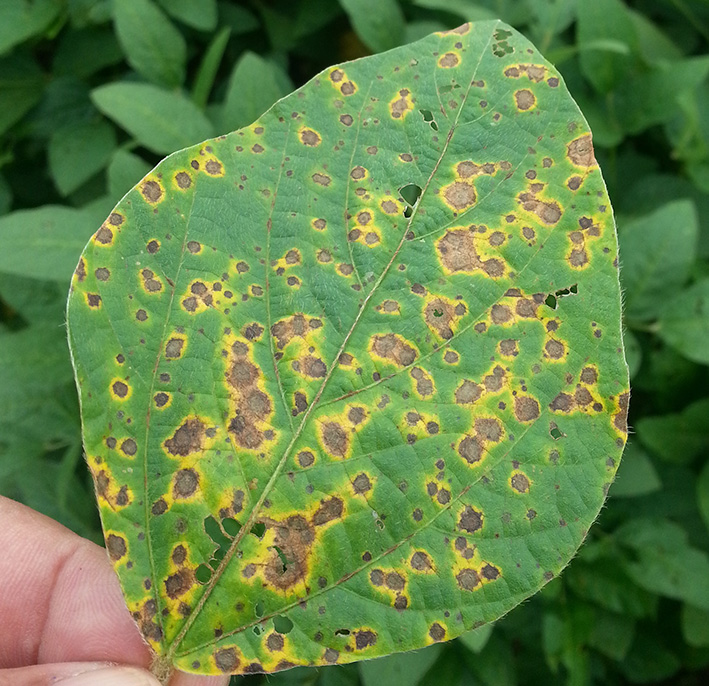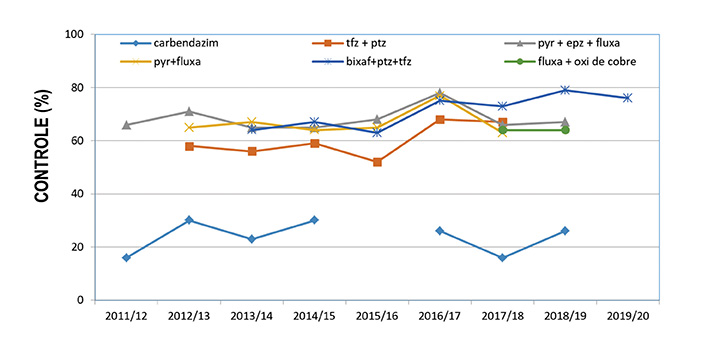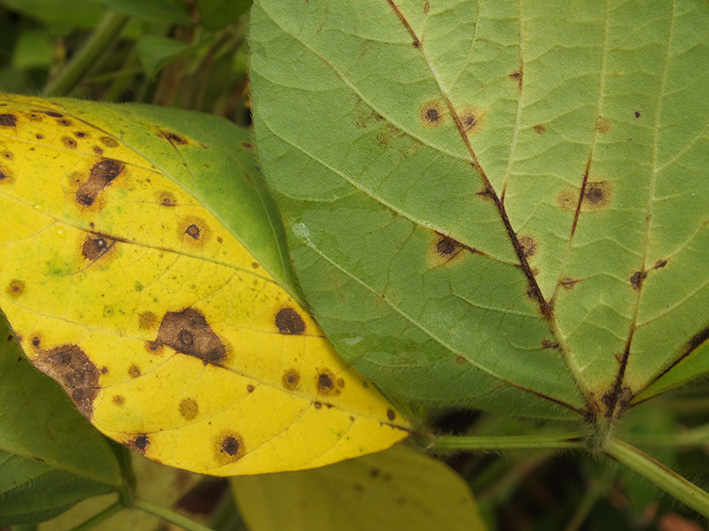Soybean planting is completed in RS
69% of the cultivated area is in germination/vegetative development; 24%, in flowering; and 7% in grain filling
The occurrence of diseases in soybean crops has changed in recent years due to changes in the production system. Although Asian rust stands out for being the most severe disease and for occurring in most producing regions, management measures such as sanitary emptiness and the concentration of sowing at the beginning of the recommended season with early cultivars have caused the incidence of this disease to increase. occurs increasingly later in regions and crops, being a problem mainly at the end of the cycle or in later sowings due to the increase in inoculum. Asian rust, due to its severity, when present in crops, causes early defoliation, making it difficult to observe other foliar diseases due to competition for leaf tissue.
However, increasingly, in sowings shortly after the end of the sanitary void, other foliar diseases have predominated in crops until the appearance of Asian rust. The target spot stands out, caused by the fungus Corynespora cassiicola. The incidence of this disease has increased in recent harvests. Although most breeding programs do not select for resistance to C. cassiicola, There is a difference in reaction between cultivars. Losses of up to 40% can be observed in susceptible cultivars. Another factor that has contributed to the presence of this disease in the field is the fungus' lower sensitivity/resistance to the fungicides most commonly used in soybean crops.
The symptoms of target spot on the leaves begin with brown spots, with a yellowish halo, evolving into circular spots, light brown to dark brown. Normally, the spots have a punctuation in the center and concentric rings of darker color, hence the name target spot. Depending on the cultivar's reaction, the lesions can reach up to 2cm in diameter or remain small (1mm to 3mm), but in greater numbers. Spots may also occur on petioles, stems, leaf veins and pods, often being confused with anthracnose. Susceptible cultivars may suffer early defoliation. Some cultivars have good tolerance to defoliation and the presence of the disease is only noticeable on the lower leaves.

In addition to soybeans, the fungus C. cassiicola infects more than 400 species of plants, which include important crops used in rotation or succession, such as cotton and sunn hemp, as well as several weeds. The fungus can colonize a wide range of soil residues and survive in crop residues and infected seeds.
Knowing the cultivar's reaction to the target spot is important when defining the fungicide management program. Not all fungicides are effective in controlling the fungus. C. cassiicola. Since the 2011/2012 harvest, network experiments have been carried out in different producing regions to compare the efficiency of registered fungicides and those in the registration phase for controlling target spot in soybean crops. The objective of network experiments is to evaluate the control efficiency on the biological target. For this purpose, sequential applications of fungicides are used. However, this does not constitute a recommendation for control. The information must be used within a management system, considering the incidence of other diseases and always prioritizing the rotation of fungicides with different modes of action to delay the emergence of fungal resistance to fungicides.
In the 2019/2020 harvest, 20 experiments were carried out by 15 research institutions, at experimental stations in Mato Grosso do Sul, Mato Grosso, Goiás, Tocantins and Bahia, where the disease has been more severe. Five fungicides were evaluated, in addition to the untreated control (Table 1). The fungicide used in treatment 2 is registered with the Ministry of Agriculture, Livestock and Supply (Mapa) for the control of target spot in soybeans and the fungicides in treatments 3 to 6 are Special Temporary Registration III (RET III). Applications began at pre-closing of the sowing lines (45-50 days after germination), repeated at intervals of 14 days, totaling three to four applications.
In all experiments, cultivars considered susceptible to the target spot were used, based on field observations. The areas for installing the experiments were sown at the beginning of the recommended season, to reduce the probability of incidence of Asian rust. In the joint analysis of the experiments, 15 locations were used for severity and 13 for productivity (Table 1).

The lowest severities and highest percentages of control were observed in treatments with fluxapyroxad + prothioconazole (T3 - 78%), azoxystrobin + prothioconazole + mancozeb (T5 - 78%) and bixafen + prothioconazole + trifloxystrobin (T2 - 76%), followed by prothioconazole + fluindapir (T6 – 73%) (Table 1).
The highest yields were observed for treatments with azoxystrobin + prothioconazole + mancozeb (T5 – 4.229kg ha-1), bixafen + prothioconazole + trifloxystrobin (T2 – 4.167kg ha-1), prothioconazole + fluindapyr (T6 – 4.110kg ha-1 ) and fluxapyroxad + prothioconazole (T3 – 4.087kg ha-1) (Table 1). The average productivity reduction of the control without fungicide in relation to the highest productivity (T5) was 17,3%.
As in previous years of network experiments, fungicides containing prothioconazole have shown the best control efficiencies for target spot, as have products containing fluxapyroxad (Figure 1). Multisite fungicides, such as mancozeb, also help in controlling target spot, being important especially in regions where less sensitivity of the fungus to site-specific fungicides has been reported. The results of registered, site-specific and multi-site products, in evaluations of previous harvests, can be consulted in the technical circulars available at: https://www.embrapa.br/soja/publicacoes.
Reports of fungus resistance C. cassiicola fungicides have been increasing. The low disease control efficiency with carbendazim (methyl benzimidazole carbamate) has been observed in network trials since 2011/12 (Figure 2). Commercial fungicides in this group act by inhibiting the assembly of spindle microtubules during nuclear division by binding to the protein β-tubulin. Resistant populations may present mutations in the β-tubulin protein. The E198A and F200Y point mutations in the β-tubulin gene, which confer complete resistance, were found in isolates of C. cassiicola obtained from soybean leaves from plants collected in Mato Grosso, Paraná and Mato Grosso do Sul (Mello, 2009), which may explain the low efficiency of this fungicide.

The G143A mutation, which confers complete resistance to external quinone inhibitor fungicides (strobilurins), was detected in a significant number of samples in Brazil in 2015 and 2016 in isolates of C. cassiicola in Mato Grosso, Mato Grosso do Sul and Paraná (Frac, 2019). In 2017/2018, isolates with the sdhB-H278Y and sdhC-N75S mutations that confer less sensitivity of the fungus to fungicides that inhibit succinate dehydrogenase (carboxamides) were reported by the Fungicide Resistance Action Committee (Frac), mainly in soybean areas in succession with cotton.

Reports of resistance reinforce the need to adopt anti-resistance strategies, such as limiting the number of carboxamide applications to two applications per soybean crop cycle, and adopting all disease management strategies, such as the use of resistant/tolerant cultivars. , seed treatment and crop rotation/succession with corn and/or other grass species.
Knowing the cultivar's reaction to the target spot is the first step in defining a fungicide management program. Many cultivars have good tolerance/resistance to this disease and do not require control, and for those that do, it is necessary to choose the appropriate fungicide, since not all of them have good efficiency.
Cláudia Vieira Godoy, Maurício Conrado Meyer and Ivani de Oliveira N. Lopes, Embrapa Soja; Carlos Mitinori Utiamada, Tagro Agricultural Technology; Hercules Diniz Campos, UniRV/ Campos Agricultural Research; Alfredo R. Dias, Chapadão Foundation; José Nunes Junior and Cláudia Barbosa Pimenta, CTPA/Emater – GO; Diego Sichocki and Luís Antônio de Sousa Lima, Meta Consultoria Agrícola; Eder Novaes Moreira, Fitolab Agricultural Research and Development; Tiago F. Konageski and Fabíola T. Konageski, Rural Técnica Experimentos Agronomicos Ltda.; José Fernando J. Grigolli, MS Foundation; Luana M. de R. Belufi, Rio Verde Foundation; Luís Henrique Carregal, Agro Carregal Research and Plant Protection Eireli; Marcio Goussain Júnior, Assist Consultoria; Moab Diany Dias, Federal University of Tocantins; Mônica Cagnin Martins, Círculo Verde Agronomic Advisory and Research; Mônica A. Müller and Josiclea H. Arruda, Fundação MT; Valtemir J. Carlin, Agrodynamics Agricultural Research and Consultancy

Receive the latest agriculture news by email